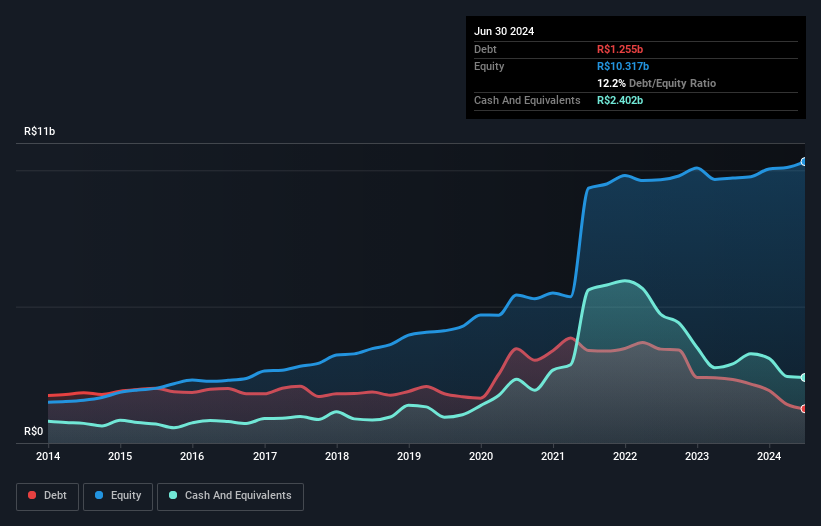These 4 Measures Indicate That Lojas Renner (BVMF:LREN3) Is Using Debt Safely
Some say volatility, rather than debt, is the best way to think about risk as an investor, but Warren Buffett famously said that 'Volatility is far from synonymous with risk.' When we think about how risky a company is, we always like to look at its use of debt, since debt overload can lead to ruin. Importantly, Lojas Renner S.A. (BVMF:LREN3) does carry debt. But the real question is whether this debt is making the company risky.
When Is Debt A Problem?
Debt is a tool to help businesses grow, but if a business is incapable of paying off its lenders, then it exists at their mercy. Part and parcel of capitalism is the process of 'creative destruction' where failed businesses are mercilessly liquidated by their bankers. However, a more usual (but still expensive) situation is where a company must dilute shareholders at a cheap share price simply to get debt under control. Of course, the upside of debt is that it often represents cheap capital, especially when it replaces dilution in a company with the ability to reinvest at high rates of return. The first thing to do when considering how much debt a business uses is to look at its cash and debt together.
Check out our latest analysis for Lojas Renner
What Is Lojas Renner's Net Debt?
The image below, which you can click on for greater detail, shows that Lojas Renner had debt of R$1.26b at the end of June 2024, a reduction from R$2.33b over a year. However, its balance sheet shows it holds R$2.40b in cash, so it actually has R$1.15b net cash.

A Look At Lojas Renner's Liabilities
We can see from the most recent balance sheet that Lojas Renner had liabilities of R$6.72b falling due within a year, and liabilities of R$2.20b due beyond that. Offsetting these obligations, it had cash of R$2.40b as well as receivables valued at R$6.71b due within 12 months. So it actually has R$180.6m more liquid assets than total liabilities.
Having regard to Lojas Renner's size, it seems that its liquid assets are well balanced with its total liabilities. So it's very unlikely that the R$18.1b company is short on cash, but still worth keeping an eye on the balance sheet. Simply put, the fact that Lojas Renner has more cash than debt is arguably a good indication that it can manage its debt safely.
Also good is that Lojas Renner grew its EBIT at 17% over the last year, further increasing its ability to manage debt. When analysing debt levels, the balance sheet is the obvious place to start. But ultimately the future profitability of the business will decide if Lojas Renner can strengthen its balance sheet over time. So if you want to see what the professionals think, you might find this free report on analyst profit forecasts to be interesting.
But our final consideration is also important, because a company cannot pay debt with paper profits; it needs cold hard cash. Lojas Renner may have net cash on the balance sheet, but it is still interesting to look at how well the business converts its earnings before interest and tax (EBIT) to free cash flow, because that will influence both its need for, and its capacity to manage debt. Happily for any shareholders, Lojas Renner actually produced more free cash flow than EBIT over the last three years. There's nothing better than incoming cash when it comes to staying in your lenders' good graces.
Summing Up
While we empathize with investors who find debt concerning, you should keep in mind that Lojas Renner has net cash of R$1.15b, as well as more liquid assets than liabilities. And it impressed us with free cash flow of R$2.1b, being 106% of its EBIT. So is Lojas Renner's debt a risk? It doesn't seem so to us. When analysing debt levels, the balance sheet is the obvious place to start. However, not all investment risk resides within the balance sheet - far from it. Case in point: We've spotted 1 warning sign for Lojas Renner you should be aware of.
If you're interested in investing in businesses that can grow profits without the burden of debt, then check out this free list of growing businesses that have net cash on the balance sheet.
Have feedback on this article? Concerned about the content? Get in touch with us directly. Alternatively, email editorial-team (at) simplywallst.com.
This article by Simply Wall St is general in nature. We provide commentary based on historical data and analyst forecasts only using an unbiased methodology and our articles are not intended to be financial advice. It does not constitute a recommendation to buy or sell any stock, and does not take account of your objectives, or your financial situation. We aim to bring you long-term focused analysis driven by fundamental data. Note that our analysis may not factor in the latest price-sensitive company announcements or qualitative material. Simply Wall St has no position in any stocks mentioned.
 Index Options
Index Options CME Group
CME Group Nasdaq
Nasdaq Cboe
Cboe TradingView
TradingView Wall Street Journal
Wall Street Journal